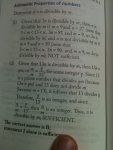I'm studying for the GMAT and am very, very rusty on high-school level algebra. When reading the explanation, I understand how the problem is solved, but I don't understand how you could easily arrive at the conclusion. I seems as though you would just have to have a "lucky guess" to stumble upon the answer.
**Here's the question, ---- I need to determine if statement 1 alone is sufficient info to answer the question, if statement 2 alone is sufficient, if both statements together are sufficient, if each statement alone is sufficient, or if NEITHER statement is sufficient.
Q:
A teacher will assign each student in a group of N students to one of M classrooms. If 3<M<13<N, is it possible to assign each of the N students to one of the M classrooms so that each classroom has the same number of students assigned to it?
1) It is possible to assign each of 3N students to one of M classrooms so that each class has the same number of students
2) It is possible to assign each of 13N students to one of M classrooms so that each class has the same number of students
A:
The answer is that "2" only is sufficient to answer the question. I've attached a snapshot of the explanation in the book. Perhaps if someone could solve this using a different method, it might cause a light bulb to come on for me.
I just don't understand how you could "know" to set up the equations the way they are set up in the answer for the 2nd option.
**Here's the question, ---- I need to determine if statement 1 alone is sufficient info to answer the question, if statement 2 alone is sufficient, if both statements together are sufficient, if each statement alone is sufficient, or if NEITHER statement is sufficient.
Q:
A teacher will assign each student in a group of N students to one of M classrooms. If 3<M<13<N, is it possible to assign each of the N students to one of the M classrooms so that each classroom has the same number of students assigned to it?
1) It is possible to assign each of 3N students to one of M classrooms so that each class has the same number of students
2) It is possible to assign each of 13N students to one of M classrooms so that each class has the same number of students
A:
The answer is that "2" only is sufficient to answer the question. I've attached a snapshot of the explanation in the book. Perhaps if someone could solve this using a different method, it might cause a light bulb to come on for me.
I just don't understand how you could "know" to set up the equations the way they are set up in the answer for the 2nd option.

